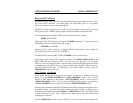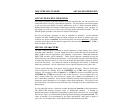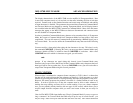
MFJ-1278B MULTI-MODE ADVANCED OPERATION
ADVANCED PACKET OPERATION
This chapter describes some other aspects of Packet operation that you will not need to be
concerned with for everyday conversational operation. You will want to consult this chapter
if you are using your station for special applications such as a Packet Personal Mailbox,
Bulletin Board, binary file transfers, Packet picture transfers or running a "host" program. In
this chapter also discuss use of the newly developed packet anti-collision feature. HF and
OSCAR packet operation is also discuss in detail in this chapter.
We will use the term "computer" to refer to computers or terminals. In the command
examples, the MFJ-1278B's prompts and other messages are shown in ordinary type, your
responses are shown in bold face, and received packets are shown underlined. Commands
and other special keywords are shown in upper case; other text entered to the MFJ-1278B is
shown in upper and lower case.
SPECIAL CHARACTERS
The MFJ-1278B recognizes a number of special characters for input editing, flow control,
and other control functions. You can change any of these special characters to customize the
MFJ-1278B to suit your applications, your computer, or your whim. Commands within the
MFJ-1278B set these special characters. These special character commands specify the
ASCII character code for the desired character. You can disable any special character feature
by setting the character value to 0. The user can disable the input editing characters without
no serious side-effects. You should use caution in disabling the flow-control or Command
Mode entry characters. Also be careful not to set two special characters to the same value.
Various control characters are normally used for special characters. The user would enter
control characters by holding down the CONTROL key, CTRL while typing another
character. For example, to enter a Control-C, or <CTRL-C>, the user would hold down the
CONTROL key, CTRL and press the C key at the same time. If your computer does not
have a special control key, you will have to consult your computer's documentation to see
how to enter these characters. If you will have difficulty entering control characters, you can
change the special characters to, for example, seldom used punctuation. The action of each
special character is described in detail under the entry in Chapter 6 for the command that sets
that character.
You can enter the code for a character in either Hexadecimal (base 16) or Decimal notation.
The MFJ-1278B displays character codes in Hexidecimal notation. A number in
Hexidecimal notation is indicated by beginning a number with a $ in front of it, such as $1B.
Each of the "digits" of a Hexidecimal number represents multiples of the powers of 16. The
values 10 through 15 are represented by the letters A through F, which may be upper or
lower case. For example, take a look at break down of hexidecimal value $1B:


















